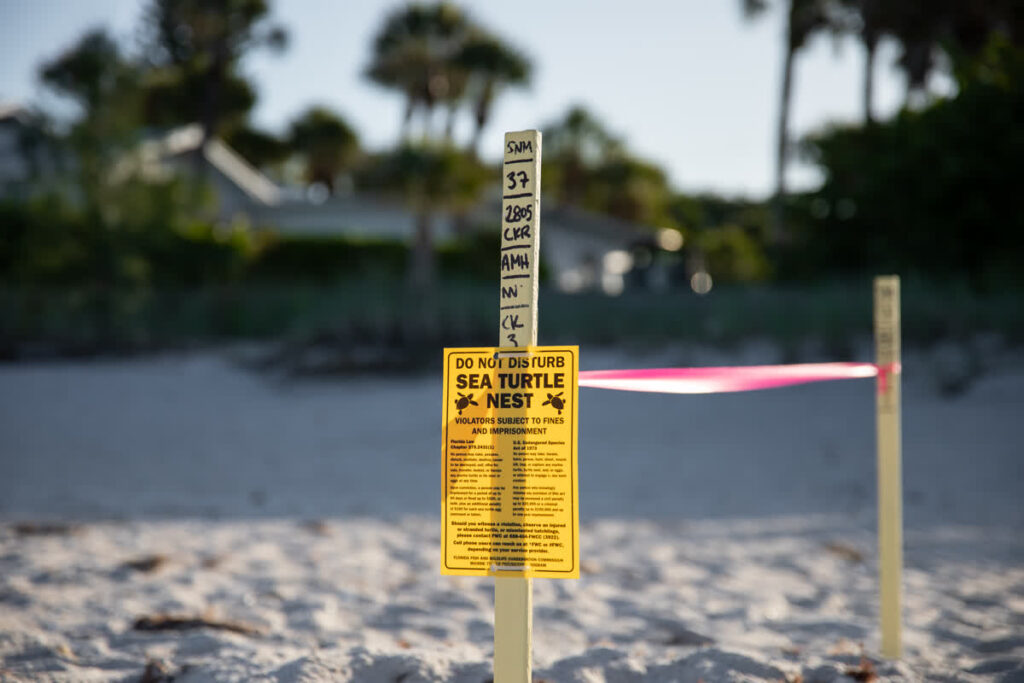A study by Mote Marine Laboratory, spanning over four decades investigating the nesting behaviors and productivity of marine turtles along the Gulf of Mexico coastline, confirms the effectiveness of Mote’s current conservation efforts. It also substantiates the importance of events like Run for the Turtles, which help fund these successful efforts.
Conducted by the Mote Marine Laboratory Sea Turtle Conservation and Research Program (STCRP), this research provides critical insights into the dynamics of marine turtle populations and their implications for conservation efforts. Most notably, the study highlights the significance of long-term data sets (collected over 40 years) in understanding marine turtle populations.
“Long-term data sets are indispensable for developing effective conservation strategies for threatened and endangered species like marine turtles,” said Dr. Jake Lasala, Program Manager of the Sea Turtle Conservation and Research Program. “They allow us to discern trends, understand population dynamics, and identify key factors influencing nesting success.”
Conducted across five beaches in Sarasota County, Florida, since 1982, the research involved standardized monitoring of nesting habitats. STCRP staff and volunteers meticulously tracked marine turtle nesting activity, collecting data on nest counts, nesting density, nesting success, incubation duration, and emergence success. This extensive dataset provided valuable insights into the nesting behaviors and reproductive success of loggerhead and green sea turtles.
Key findings from the study include:
Increasing Nesting Counts: Both loggerhead and green sea turtle nesting counts have steadily increased since monitoring began, indicating positive trends in nesting activity over the decades.
Phenological (the study of cyclic/ seasonal natural phenomena) Shifts: The timing of nesting events has shifted earlier in the year for both loggerheads and green sea turtles, with implications for nesting season duration and reproductive success.
Nesting Density (the number of nests in a given area) and Success (the proportion of emergences that resulted in a nest/egg deposition in relation to the total number of crawls/attempts): Nesting density has significantly increased over time for loggerheads, while green sea turtle nesting density has shown a moderate increase. Nesting success varied between beaches, with some locations demonstrating higher success rates than others.
Incubation (developing eggs) and Emergence Success: Incubation duration has lengthened over the study period for both loggerheads and green sea turtles. However, emergence success has shown a decline for loggerheads but remained stable for green sea turtles.
Effects of Nest Site Selection: Nesting success and emergence success were influenced by nest site selection, with turtles demonstrating preferences for specific beach locations.
Nesting and Breeding Discrepancy: While loggerhead nesting counts have increased across Florida beaches, the study points out a lack of evidence for a significant increase in the overall number of breeding females over the past three decades, which has hindered a strong recovery of the overall population.
“We would not have reached this tremendous feat without the hundreds of volunteers and interns that we’ve had over the past four decades,” said Melissa Macksey, Senior Biologist and Conservation Manager of the STCRP. “Further research is needed to continue fostering our understanding of nesting trends and environmental impacts, and the people behind the monitoring make it possible.”
The study underscores the imperative for additional research to enhance scientific comprehension and preservation of these species. Events such as Run for the Turtles directly support the Sea Turtle Conservation and Research Program. Run for the Turtle’s contributions enable the program to continue its vital research efforts and delve deeper into the issues facing Gulf Coast turtle populations.
The 38th Annual Run for the Turtles presents an opportunity for participants to engage in a meaningful cause while embracing the beauty of Siesta Key Beach. Whether running or walking, supporters can contribute to the critical efforts of the Sea Turtle Conservation & Research Program at Mote Marine Laboratory. This esteemed event serves as the primary fundraiser for the program, enabling ongoing initiatives such as daily beach surveys, turtle tagging, and satellite tracking.
Whether joining in-person or virtually, participants demonstrate their commitment to the preservation of endangered and threatened sea turtles, reinforcing the importance of collective action in conservation endeavors.
To sign up or find out more about the 38th Annual Run for the Turtles event, please visit https://mote.org/events/details/run-for-the-turtles-2024.
To read the full study, please visit https://www.nature.com/articles/s41598-023-43651-4?utm_source=rct_congratemailt&utm_medium=email&utm_campaign=oa_20231011&utm_content=10.1038/s41598-023-43651-4.
About Mote: Mote Marine Laboratory & Aquarium is an independent, nonprofit, 501(c)3 research institution founded in 1955. Mote began and flourished through the passion of a single researcher, Dr. Eugenie Clark, her partnership with the community and philanthropic support, first of the Vanderbilt family and later of the William R. Mote family.
Today, Mote is based in Sarasota, Florida, with five campuses stretching from Sarasota to the Florida Keys. Mote has more than 20 world-class research programs studying oceans locally to internationally, with an emphasis on conservation and sustainable use of marine resources. Mote’s vision includes positively impacting public policy through science-based outreach and education. Showcasing the Lab’s research is Mote Aquarium, open from 10 a.m. to 5 p.m. 365 days a year. Learn more at mote.org.
Contact Us:
Mote Marine Laboratory and Aquarium, 1600 Ken Thompson Parkway, Sarasota, Fla., 34236. 941.388.4441
Copyright©2018 Mote Marine Laboratory and Aquarium, All rights reserved.


